| |||||||||||||||
| Probability Density Function | The general formula for the probability density function of the uniform distribution is where A is the location parameter and (B - A) is the scale parameter. The case where A = 0 and B = 1 is called the standard uniform distribution. The equation for the standard uniform distribution is  Since the general form of probability functions can be expressed in terms of the standard distribution, all subsequent formulas in this section are given for the standard form of the function. The following is the plot of the uniform probability density function. 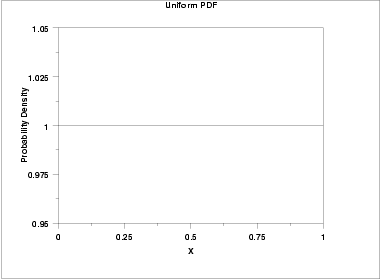 | ||||||||||||||
| Cumulative Distribution Function | The formula for the cumulative distribution function of the uniform distribution is The following is the plot of the uniform cumulative distribution function. 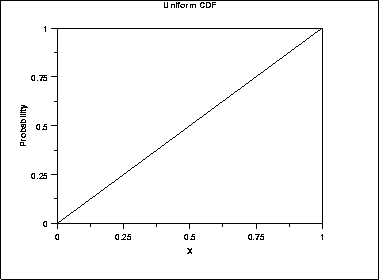 | ||||||||||||||
| Percent Point Function | The formula for the percent point function of the uniform distribution is The following is the plot of the uniform percent point function. 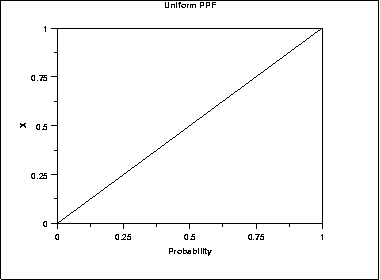 | ||||||||||||||
| Hazard Function | The formula for the hazard function of the uniform distribution is The following is the plot of the uniform hazard function. 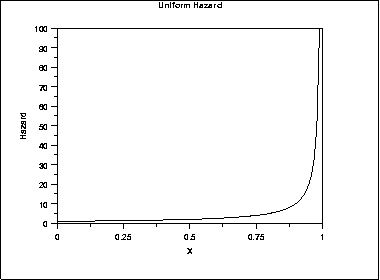 | ||||||||||||||
| Cumulative Hazard Function | The formula for the cumulative hazard function of the uniform distribution is The following is the plot of the uniform cumulative hazard function. 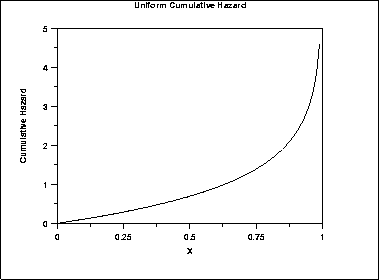 | ||||||||||||||
| Survival Function | The uniform survival function can be computed from the uniform cumulative distribution function.The following is the plot of the uniform survival function.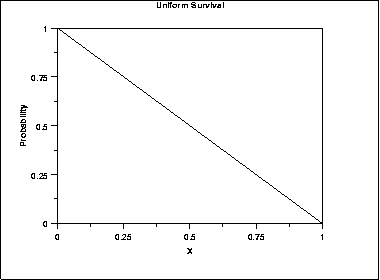 | ||||||||||||||
| Inverse Survival Function | The uniform inverse survival function can be computed from the uniform percent point function.The following is the plot of the uniform inverse survival function.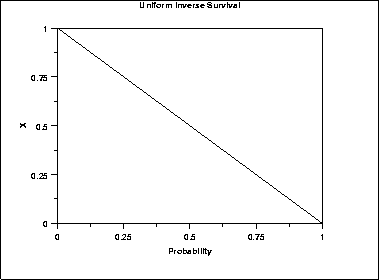 | ||||||||||||||
| Common Statistics |
| ||||||||||||||
| Parameter Estimation | The method of moments estimators for A and B are 
B = a + h  ![hhat = 0.5*[RANGE(Y1, ... , Yn)]](http://www.itl.nist.gov/div898/handbook/eda/section3/eqns/unimlh.gif) ![Ahat = midrange(Y1, ... ,Yn) - 0.5*[RANGE(Y1, ... , Yn)]](http://www.itl.nist.gov/div898/handbook/eda/section3/eqns/unimla.gif) ![Bhat = midrange(Y1, ... ,Yn) + 0.5*[RANGE(Y1, ... , Yn)]](http://www.itl.nist.gov/div898/handbook/eda/section3/eqns/unimlb.gif) | ||||||||||||||
| Comments | The uniform distribution defines equal probability over a given range for a continuous distribution. For this reason, it is important as a reference distribution.One of the most important applications of the uniform distribution is in the generation of random numbers. That is, almost all random number generators generate random numbers on the (0,1) interval. For other distributions, some transformation is applied to the uniform random numbers. | ||||||||||||||
| Software | Most general purpose statistical software programs support at least some of the probability functions for the uniform distribution. | ||||||||||||||
Runs Test for Detecting Non-randomness Purpose: Detect Non-Randomness The runs test ( Bradley, 1968 ) can be used to decide if a data set is from a random process. A run is defined as a series of increasing values or a series of decreasing values. The number of increasing, or decreasing, values is the length of the run. In a random data set, the probability that the ( I +1)th value is larger or smaller than the I th value follows a binomial distribution , which forms the basis of the runs test. Typical Analysis and Test Statistics The first step in the runs test is to count the number of runs in the data sequence. There are several ways to define runs in the literature, however, in all cases the formulation must produce a dichotomous sequence of values. For example, a series of 20 coin tosses might produce the f...


Comments
Post a Comment